Fifteen ships of the Royal Navy have been named HMS Enterprise while another was planned:
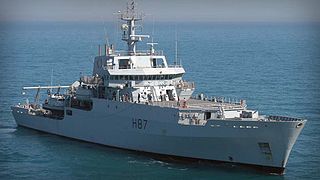
The Echo class was a class of multi-purpose hydrographic survey ships in commission with the Royal Navy. The ships were primarily tasked with conducting survey work in support of submarine and amphibious operations, however, the class also has a secondary role in mine countermeasures. The two vessels of the class were the most recent additions to the Royal Navy's Hydrographic Squadron. Each ship displaced approximately 3,700 tonnes, and was equipped with a state of the art suite of equipment. The lead ship of the class, HMS Echo, was retired in 2022 and her sister ship in 2023.
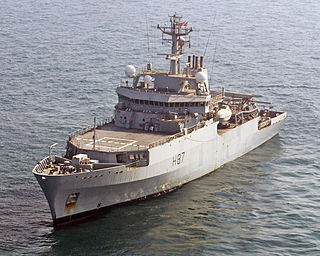
HMS Echo was the first of two multi-role hydrographic survey ships commissioned by the Royal Navy. With her sister ship, HMS Enterprise, they formed the Echo class of survey vessels. She was built by Appledore Shipbuilders in Devon in 2002 and was the ninth Royal Navy vessel to carry the name. She was retired from service in 2022.

HMS Enterprise, the tenth ship to bear this name, was a multi-role survey vessel - hydrographic oceanographic (SVHO) of the Royal Navy along with HMS Echo that made up the Echo class of survey vessels.
Eleven ships of the Royal Navy have been named HMS Scorpion after the carnivorous arthropod, or the scorpion, a ballistic weapon in use in the Roman army:

HMS Herald was a Hecla-class ocean survey ship that served with the Royal Navy during both the Falklands War and Gulf War.

HMS Hydra was a Royal Navy deep ocean hydrographic survey vessel, the third of the original three of the Hecla class. The ship was laid down as yard number 2258 on 14 May 1964 at Yarrow Shipbuilders, at Scotstoun on the River Clyde and launched on 14 July 1965 by Mary Lythall, wife of the then Chief Scientist, Basil W Lythall CB (1919–2001). She was completed and first commissioned on 4 May 1966 and, as the replacement for the survey ship HMS Owen, her commanding officer and many of her ship's company formed the first commission of HMS Hydra. She was decommissioned and sold to the Indonesian Navy in 1986 and renamed KRI Dewa Kembar ; she was still in service in 2019.

HMSGannet is a Royal Navy Doterel-class screw sloop-of-war launched on 31 August 1878. It became a training ship in the Thames in 1903, and was then loaned as a training ship for boys in the Hamble from 1913. It was restored in 1987 and is now part of the UK's National Historic Fleet.

The Echo class was a class of inshore survey vessels built for the British Royal Navy in 1958–1959. The class was designed to operate in close waters such as harbour approaches, shipping lanes, rivers and estuaries. Together, the ships of this class formed the Royal Navy's Inshore Survey Squadron.

HMS Cattistock, the third ship of this name, is a Hunt-class mine countermeasures vessel of the Royal Navy. She was launched in 1981 and commissioned on 5 March 1982, the third ship of her class.

HMS Dalrymple was a Bay-class anti-aircraft frigate of the British Royal Navy, which served as a survey ship, mostly in the Persian Gulf, from 1948 until 1965. She was completed to deal with the large numbers of uncharted wrecks and mines around the British Isles as a result of World War II. For this purpose she was fitted for minesweeping. She was named for the pioneering Hydrographer of the Admiralty Alexander Dalrymple (1737–1808).

CSS Acadia is a former hydrographic surveying and oceanographic research ship of the Hydrographic Survey of Canada and its successor the Canadian Hydrographic Service.

The Shoreham-class sloops were a class of eight warships of the Royal Navy built in the early 1930s.
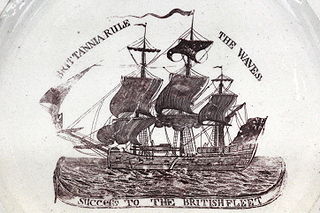
The Maritime history of the United Kingdom involves events including shipping, ports, navigation, and seamen, as well as marine sciences, exploration, trade, and maritime themes in the arts from the creation of the kingdom of Great Britain as a united, sovereign state, on 1 May 1707 in accordance with the Treaty of Union, signed on 22 July 1706. Until the advent of air transport and the creation of the Channel Tunnel, marine transport was the only way of reaching the British Isles. For this reason, maritime trade and naval power have always had great importance.

The Doom Bar is a sandbar at the mouth of the estuary of the River Camel, where it meets the Celtic Sea on the north coast of Cornwall, England. Like two other permanent sandbanks further up the estuary, the Doom Bar is composed mainly of marine sand that is continually being carried up from the seabed. More than 60 percent of the sand is derived from marine shells, making it an important source of agricultural lime, which has been collected for hundreds of years; an estimated 10 million tons of sand or more has been removed from the estuary since the early nineteenth century, mainly by dredging.
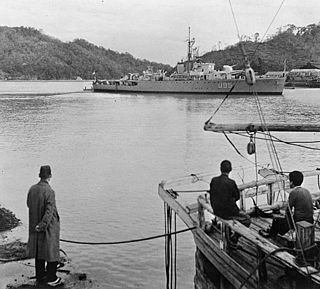
HMIS Sutlej (U95) was a modified Bittern-class sloop, later known as the Black Swan class, which served in the Royal Indian Navy (RIN) during World War II.

HMS Herald was an Atholl-class 28-gun sixth-rate corvette of the Royal Navy. She was launched in 1822 as HMS Termagant, commissioned in 1824 as HMS Herald and converted to a survey ship in 1845. After serving as a chapel ship from 1861, she was sold for breaking in 1862.
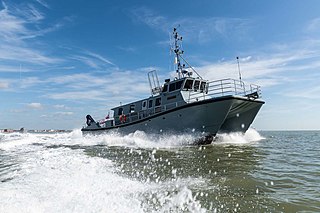
HMS Magpie is a survey ship of the Royal Navy, intended for use on inshore and coastal survey work. Magpie replaced HMS Gleaner. She was accepted by the RN in May 2018 and commissioned on 28 June 2018.

Vice-Admiral Sir John Augustine Edgell, KBE, CB, FRS was an officer in the Royal Navy and Hydrographer of the Navy from 1932 to 1945. He was noted for his support for innovations such as echo sounding and radio navigation, for the surveying and chart production operations of his department during World War II, and for his advocacy of the science of oceanography

















